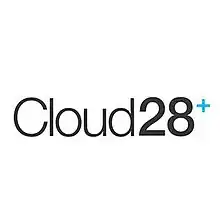Cloud28+
Cloud28+ is a worldwide cloud computing services marketplace[1] and federation of cloud computing organizations.[2] It was developed and is sponsored by Hewlett Packard Enterprise (HPE). In December 2016 it was the world's biggest aggregator of cloud computing services.[3]
 | |
| Formation | 26 March 2015 |
|---|---|
| Founder | Hewlett Packard Enterprise |
| Type | Federation |
| Purpose | Drive enterprise cloud adoption |
Region | Worldwide |
| Website | https://www.cloud28plus.com |
The federation originally launched in Europe in March 2015, with the aim of accelerating cloud adoption in Europe.[4] It opened up to members worldwide in November 2016, at which point it had around 330 member companies and offered around 1,300 infrastructure-as-a-service (IaaS), platform-as-a-service (PaaS), and software-as-a-service (SaaS) services.[5]
History
Cloud28+ launched at an HPE event in Frankfurt, Germany in March 2015. It had been in development since April 2014, with the purpose of creating a single catalogue of European cloud computing services.[6] HP had been "trying to figure out how we grow an ecosystem of cloud suppliers in Europe, mapping services providers with ISVs and resellers," according to HP executive Xavier Poisson Gouyou Beauchamps.[7]
On 6 June 2017, Poisson won the "Cloud Leadership Award 2017" from Datacloud Europe,[8] with judges citing the growth of Cloud28+ in making their selection.[9]
Microsoft joined Cloud28+ as a technology partner in July 2017, pledging to collaborate with HPE to create a new on-boarding programme designed to bring more independent software vendors (ISVs) to the marketplace.[10] In February 2018, Mphasis partnered with HPE Cloud28+ for specific solutions and services.[11][12]
Services
At launch, Cloud28+ required that services in its catalog be built on the HPE Helion version of the OpenStack open-source cloud software platform. In May 2016, support was extended to include Microsoft Azure, VMware, Docker and other technologies.[13] The service hub was also extended with an App Center, which automates installation of Docker-based applications.[14]
References
- Kunert, Paul (24 October 2016). "HPE to offer hybrid cloud hypermarket to world+dog". The Register. Retrieved 2 February 2017.
- McGrath, Sean (20 May 2016). "HPE's Cloud28+ v2.0 adopts a more open approach". TechTarget. Retrieved 2 February 2017.
- Rogers, Owen. "Hewlett Packard Enterprise's Cloud28+ plans global expansion, on-premises deployments". 451 Research. Retrieved 20 June 2017.(subscription required)
- Weinger, Mackenzie (9 November 2015). "The ex-Safe harbor stimulus effect". Financial Times. Retrieved 2 February 2017.(subscription required)
- Smolaks, Max (30 November 2016). "HPE's Cloud28+ partner program goes global". Datacenter Dynamics. Retrieved 2 February 2017.
- Chazan, Guy (7 December 2015). "Deutsche Telekom to offer 'secure' cloud storage out of US reach". Financial Times. Retrieved 5 December 2016.(subscription required)
- Kunert, Paul (19 October 2015). "HP Cloud 28+ guru: 1,000 users in 6 months? Piece of cake". The Register. Retrieved 2 February 2017.
- "Katherine Ryan Hands Out Awards at Datacloud Europe 2017 to the Winners of 10th Datacloud Awards". Datacloud Europe 2017.
- "HPE's Xavier Poisson Bestowed Datacloud Europe's Cloud Leadership Award 2017". DABCC. Retrieved 19 June 2017.
- Burton, Graeme. "Microsoft joins HPE's Cloud28+ alliance to fuel hybrid IT adoption". The Inquirer. Incisive Media. Archived from the original on 27 June 2018. Retrieved 13 July 2017.
{{cite web}}: CS1 maint: unfit URL (link) - www.ETCIO.com. "Mphasis partners with HPE Cloud28+ to enhance cloud computing - ET CIO". ETCIO.com. Retrieved 27 June 2018.
- "Mphasis ties up with HPE marketplace for cloud services". VCCircle. 8 February 2018. Retrieved 27 June 2018.
- Ciarletta, Francesca. "HPE Accelerating its Cloud28+ European Cloud Initiative". IDC. Retrieved 19 June 2017.
- Beiersmann, Stefan (20 May 2016). "HPE-Initiative Cloud28+ automatisiert App-Installation" [HPE Initiative Cloud28 + automates app installation] (in German). ZDNet. Retrieved 2 February 2017.